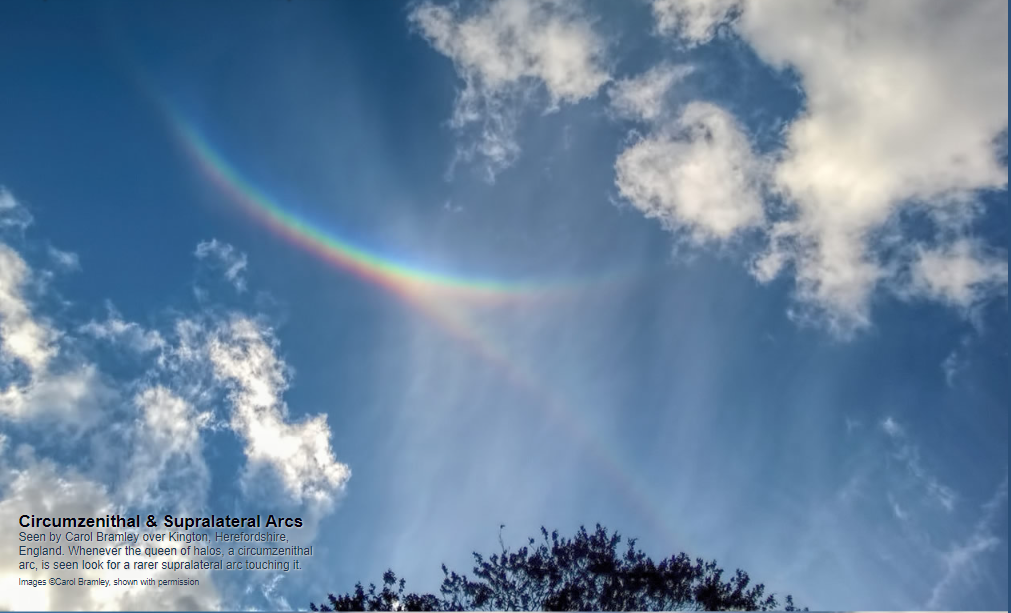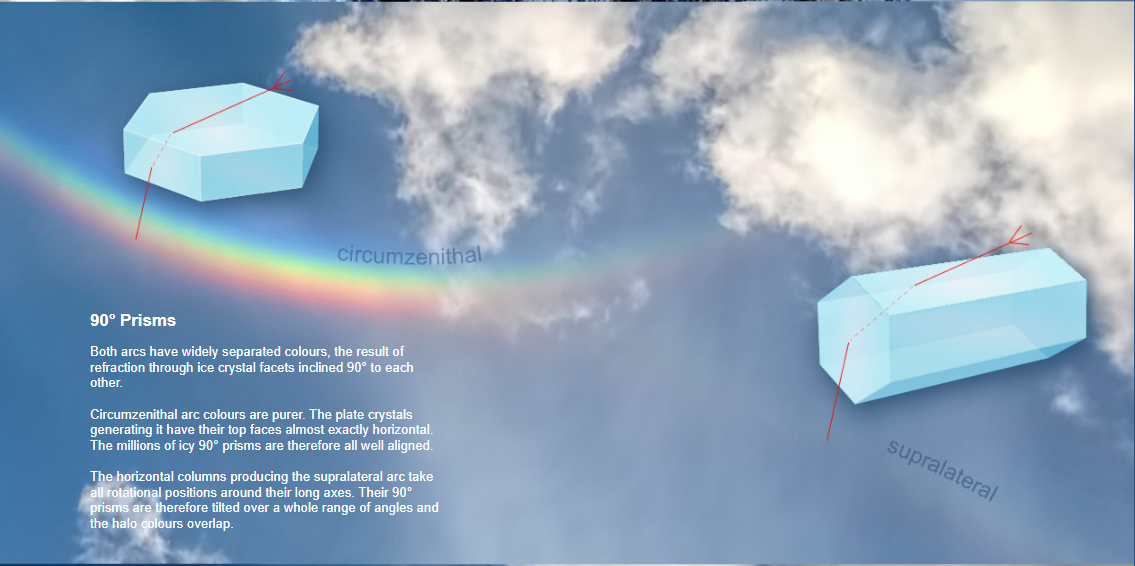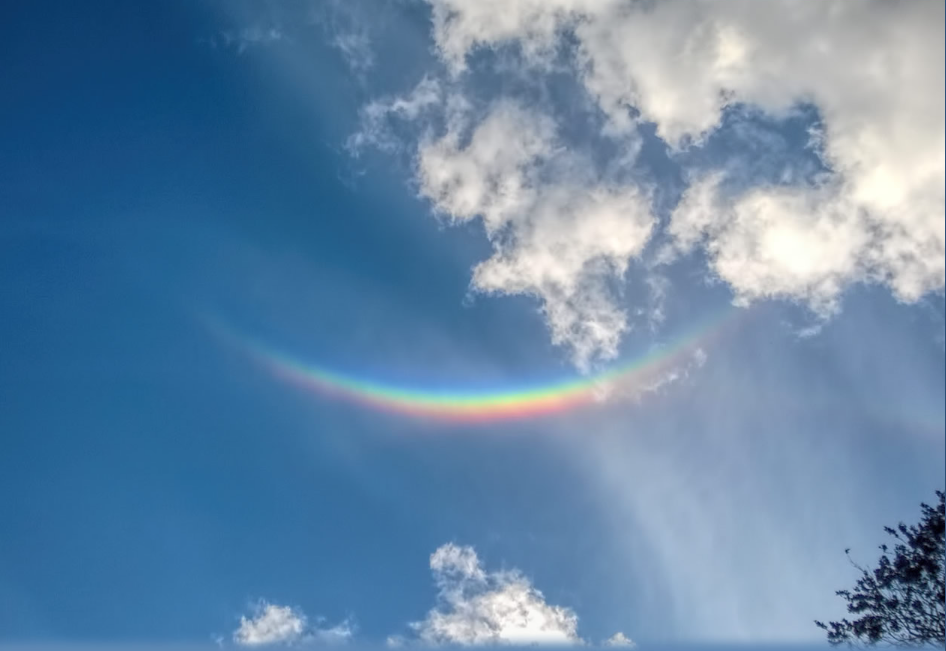Circumzenithal & Supralateral Arcs - OPOD
Circumzenithal & Supralateral Arcs - A Rare Atmospheric Phenomenon
When it comes to atmospheric optics, one of the most fascinating and rare phenomena to observe are the circumzenithal and supralateral arcs. These arcs are often referred to as the "queen of halos" due to their stunning appearance in the sky. While the circumzenithal arc is relatively more common, the presence of a supralateral arc touching it is a much rarer sight.
A Play of Colors and Ice Crystals
Both the circumzenithal and supralateral arcs exhibit a beautiful display of colors, which is a result of light refraction through ice crystal facets. These ice crystals are inclined at 90° to each other, giving rise to the distinct separation of colors in the arcs.
-
The circumzenithal arc displays purer colors. This is because the plate crystals responsible for generating this arc have their top faces almost perfectly horizontal. As a result, the millions of icy 90° prisms within these crystals are well-aligned, allowing for the pure colors to be observed.
-
On the other hand, the supralateral arc showcases a more blended mix of colors. The horizontal columns producing this arc can take various rotational positions around their long axes. Consequently, the 90° prisms within these columns are tilted at a range of angles, leading to an overlap of colors in the halo.
Unveiling the Rarity
The sighting of both the circumzenithal and supralateral arcs is a rare occurrence that requires specific atmospheric conditions and precise alignment of ice crystals. Here's what you need to know about their rarity:
-
The circumzenithal arc tends to appear more frequently than its counterpart, the supralateral arc. This is due to the specific orientation and alignment of ice crystals required for each arc's formation.
-
The supralateral arc, while rarer, is often seen when a circumzenithal arc is present. It appears as a tangent to the circumzenithal arc, creating a captivating visual effect in the sky.
Seeking the Queen of Halos
If you're eager to catch a glimpse of these ethereal atmospheric phenomena, there are a few key points to keep in mind:
-
Look towards the zenith, which is the point directly overhead. The circumzenithal arc will appear as an upwardly curved band of colors, resembling an upside-down rainbow.
-
When a circumzenithal arc is visible, carefully scan the sky around it. If atmospheric conditions are favorable, you may be fortunate enough to spot the supralateral arc touching the circumzenithal arc, forming an enchanting duo.
A Delicate Balance in the Sky
The formation of both the circumzenithal and supralateral arcs relies on a delicate balance of factors, including the presence of ice crystals and the angle at which they refract light. Here's a closer look at the mechanics behind these phenomena:
-
The circumzenithal arc occurs when sunlight passes through hexagonal ice crystals in the atmosphere. These crystals act as prisms, bending and refracting the light to create the arc.
-
The supralateral arc is formed by horizontally oriented column-shaped ice crystals. These crystals have facets inclined at 90° to each other, allowing for the refraction of light at different angles and resulting in the overlapping colors observed in the arc.
Capturing the Magic
If you're lucky enough to witness these captivating arcs, it's only natural to want to capture their beauty through photography. Here are a few tips to help you capture the magic:
-
Use a wide-angle lens to encompass as much of the sky as possible and capture the full extent of the arcs.
-
Adjust your camera settings to properly expose for the bright colors of the arcs, ensuring they are not overexposed or washed out.
-
Experiment with different compositions and angles to create visually appealing photographs. Consider including other elements in the frame, such as trees or buildings, to provide context and depth to the image.
Cherishing the Moment
The sight of both the circumzenithal and supralateral arcs is a true spectacle of nature, offering a glimpse into the wonders of atmospheric optics. Whether you're a seasoned skywatcher or a casual observer, take a moment to appreciate the rarity and beauty of these phenomena when they grace the sky above. After all, it is through these fleeting moments that we are reminded of the awe-inspiring complexity of our atmosphere and the wonders that lie just beyond our reach.

Circumzenithal & Supralateral Arcs Seen by Carol Bramley over Kington, Herefordshire, England. Whenever the queen of halos, a circumzenithal arc, is seen look for a rarer supralateral arc touching it.
Images ©Carol Bramley, shown with permission

90° Prisms
Both arcs have widely separated colours, the result of refraction through ice crystal facets inclined 90° to each other.
Circumzenithal arc colours are purer. The plate crystals generating it have their top faces almost exactly horizontal. The millions of icy 90° prisms are therefore all well aligned.
The horizontal columns producing the supralateral arc take all rotational positions around their long axes. Their 90° prisms are therefore tilted over a whole range of angles and the halo colours overlap.

Note: this article has been automatically converted from the old site and may not appear as intended. You can find the original article here.
Reference Atmospheric Optics
If you use any of the definitions, information, or data presented on Atmospheric Optics, please copy the link or reference below to properly credit us as the reference source. Thank you!
-
<a href="https://atoptics.co.uk/blog/circumzenithal-supralateral-arcs-opod/">Circumzenithal & Supralateral Arcs - OPOD</a>
-
"Circumzenithal & Supralateral Arcs - OPOD". Atmospheric Optics. Accessed on April 19, 2024. https://atoptics.co.uk/blog/circumzenithal-supralateral-arcs-opod/.
-
"Circumzenithal & Supralateral Arcs - OPOD". Atmospheric Optics, https://atoptics.co.uk/blog/circumzenithal-supralateral-arcs-opod/. Accessed 19 April, 2024
-
Circumzenithal & Supralateral Arcs - OPOD. Atmospheric Optics. Retrieved from https://atoptics.co.uk/blog/circumzenithal-supralateral-arcs-opod/.